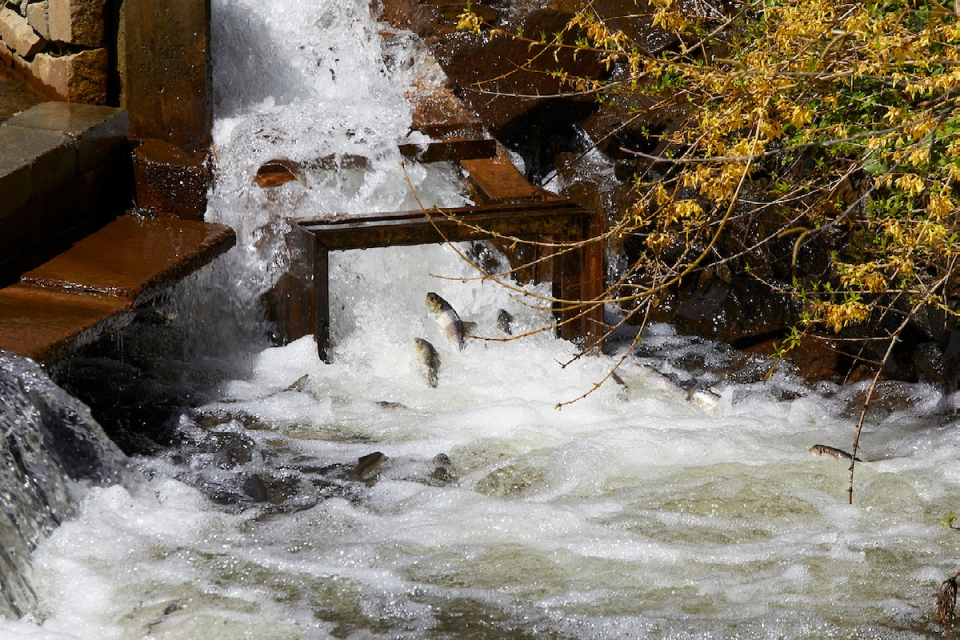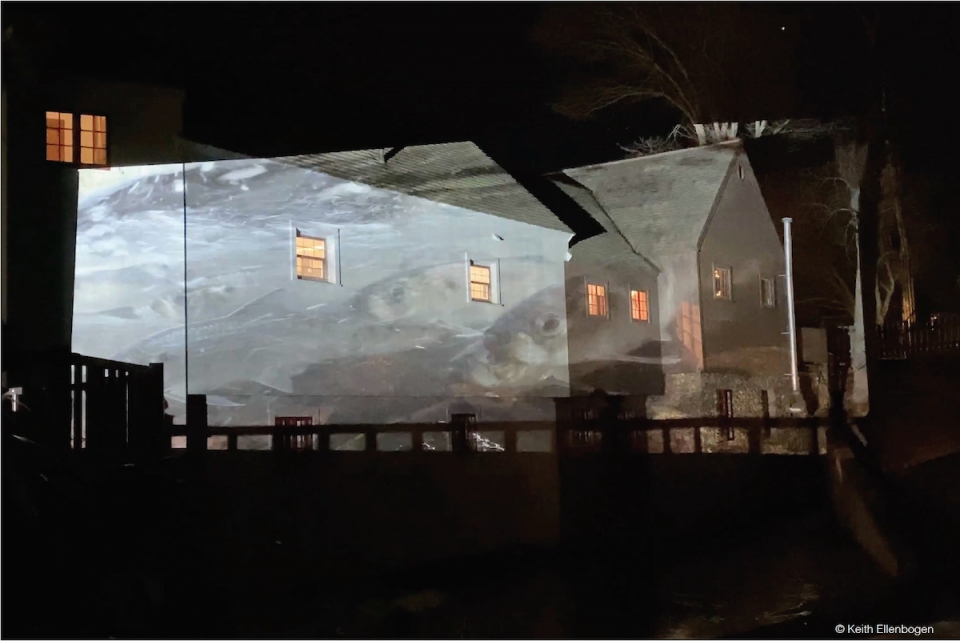
Massachusetts fish conservation project gets Sun Devil boost
Two men. A restored brook. A historic site. Thousands of fish.
And one big Sun Devil surprise.
All of them unexpectedly came together in a project to restore the herring run at Town Brook in Plymouth, Massachusetts.
At the end of the first week of every April, hundreds of thousands of river herring migrate from the ocean up into coastal streams along the East Coast. In the town of Plymouth, there are five herring runs, including the historic run at Town Brook. Pilgrim settlers used the brook for fresh water. The local Wampanoag people taught them to catch herring and eels both as food and as fertilizer for crops.

River herring accelerate up a fish ladder at Town Brook, Plymouth, Massachusetts. Photo by Keith Ellenbogen
But since 1620 there have been a lot of changes to the brook, which runs for 1.7 miles and empties into Plymouth Harbor, only a few hundred yards from Plymouth Rock. Six dams were built along the small stream to power mills during the Industrial Revolution. Ponds behind the dams became choked with sediment. The annual herring run was thwarted or completely stopped in places.
Enter Arizona State University alumnus David Gould, the director of the Department of Marine and Environmental Affairs for the town of Plymouth. Gould graduated from ASU in 1998 with a master’s degree in environmental planning.
Gould has been the project manager on numerous dam removal projects along with several large-scale wetlands restoration projects. He started work on the Town Brook dams in 2001. It was the first dam removal in Massachusetts.
He partnered with the National Oceanic and Atmospheric Administration, the United States Fish and Wildlife Service, and the Commonwealth of Massachusetts Division of Ecological Restoration to remove five dams from the brook. It involved the removal and disposal of contaminated sediments from the dam ponds, daylighting buried sections of the brook, constructing natural stream channels, restoring wetlands, and park and trail improvements.

David Gould, director of the town of Plymouth Department of Marine and Environmental Affairs, counts riveting herring in 2020 near Plymouth, Massachusetts. Photo by Keith Ellenbogen
The last remaining dam on the brook is the old Jenney Pond Dam, originating in 1636. Gould and the other partners are currently working on a natural bypass around the dam to help upstream and downstream passage of river herring and American eel.
A colleague with the National Marine Fisheries Service told Gould about a photographer working on a book documenting marine wildlife of New England.
“He said, 'I have a photographer that we've been talking to who's been doing some really neat underwater photography,'” Gould said. “'It'd be great if he could see the work at Town Brook and get some of the photos there. It's a pretty high profile project area for NOAA and the photos could be useful in trying to get the information and word out about all the work that's been done on the brook.'”
Enter Keith Ellenbogen, another ASU alumnus. He's an underwater photographer who focuses on environmental conservation, an assistant professor of photography at SUNY/The Fashion Institute of Technology and a visiting scholar/artist at the Massachusetts Institute of Technology. He graduated from ASU in 1994, from the College of Public Programs.

Town Brook, Plymouth, Massachusetts. Photo by Keith Ellenbogen
“I've always been interested in marine life and marine wildlife photography,” Ellenbogen said. “And I'm doing a project locally on New England's marine wildlife. I got connected to David because I'm fascinated by these fish called the alewife river herring. … I got connected to him and sort of very interested in photographing it only to find out sometime later that both of us were graduates of ASU. It made our bond, which was already immediate over these fantastic fish, grow even stronger as we both had a shared experience from our college days.”
Two guys, from Massachusetts, who are fascinated with alewives, and they both went to ASU?
“It seems very low in the odds, but nonetheless it's pretty special,” Ellenbogen said.
“Being someone who's a super-proud Sun Devil, I thought it was pretty neat that we had two Sun Devils working on this project,” Gould said. “I mean, what are the chances of that happening? When we would joke with people about it, they would always be like, 'Wow, that's really cool.'”
The dam removal and subsequent herring runs are immensely popular with the public. Many people had no idea a migration like this, which is more common in the Pacific Northwest, happens in New England in the middle of Plymouth. Anywhere between 175,000 and 200,000 fish migrate up the little stream.
“I think people are mostly surprised and amazed that this marine life is right here right at the river's edge by these houses in this beautiful town of Plymouth,” Ellenbogen said. “It's one of the few places you can really see these large numbers of fish. … It's a beautiful walkway and it's a time where they can really see nature do some extraordinary things. So you see kids, you see parents, you see grandparents, the whole wide spectrum of people, tourists or locals all sort of enjoying a really beautiful area.”
For many, the alewives running, like flowers beginning to sprout in the woods, are a sign that spring has arrived after a brutal New England winter.

CLEAR Lab public art video projection, Plymouth, Massachusetts. Photo by Keith Ellenbogen
“Once they see the fish running in the spring, that's like confirmation — you know spring is really here,” Gould said. “When we're out working on the brook, we always have people walking by saying, ‘Hey, the fish running yet?’ … People just look forward to it, including myself.”
The team will be using Ellenbogen’s images in the future (postpandemic) along the brook, including as a projection of video images under the bridges adjacent to the path that runs along the brook. This projection provides an immersion experience at night for visitors. He is also developing a program to be used at the school district’s planetarium to immerse students in the feel of the riverine environment that the fish migrate through in the spring.
“Part of the work is to do two things,” Ellenbogen said. “One to capture the photos and to photograph the marine life. And the second is to engage the public. We're doing a project where we're going to project them quite large on the side of a building during the evening hours and allow people to sort of hear the river and to experience what it's like to see the river herring right there during the run. It's an exciting way to use photography to amplify a message and then to project it really big and to give these fishes grandiose sort of feeling.”
More than 2,600 miles away and two decades later, Gould and Ellenbogen still say "Go Devils."
Gould brought his children to Tempe in 2015 for a campus visit.
“I’d love to come back and visit,” Ellenbogen said. “I really miss it.”
Top image: Alewife (Alosa pseudoharengus) and blueback (Alosa aestivalis) river herring during migration in Town Brook, Plymouth, Massachusetts. All photos courtesy of Keith Ellenbogen.